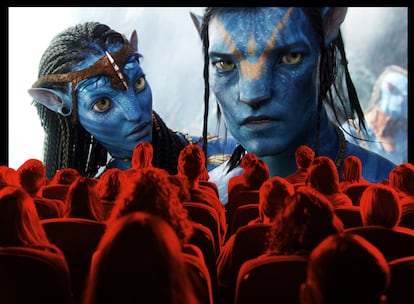Avatar’s cult following: ‘I heard voices telling me what to do’
James Cameron’s 2009 film has attracted a global community of believers who are much more than fans – they’ve learned the Na’vi language, share their spirituality and some even feel a kind of power from that fictional world

Something clicked for TOVI when they first saw Avatar back when it came out in 2009. “I grew up with autism and other problems, and always had trouble connecting with other people. I found refuge in stories, art and puzzles. The idea of escaping to a new world where I wasn’t me, where I didn’t struggle every day to get my brain to cooperate – it was a wild dream of mine,” said TOVI. In James Cameron’s film about a paraplegic soldier who transfers his consciousness into the body of a Na’vi man from Pandora returned to theaters on September 23, 13 years after its original release, to prep audiences for the long-awaited sequel in December.
TOVI is 28 years old and identifies as non-binary. They are part of a huge community of Avatar fans that visit Kelutral.org to study Na’vi, the language of the fictional people indigenous to a planet called Pandora. They went to see the film with their boyfriend when it first came out. “Sadly, his health took a turn for the worse during his senior year of high school,” they said, “and his cancer came back. We lost him in 2011. He identified with Eywa [a Na’vi deity] and the Na’vi concept of an afterlife. That meant a lot to me and helped me cope with my grief. It also makes it hard to watch the movie now, because it brings back so many memories.” TOVI says that when Avatar: The Path of Water opens in theaters on December 16, they will buy two tickets and put a photo of their deceased boyfriend in the empty seat. “He was very sad that there was such a long wait for an Avatar sequel, so I want to somehow make it possible for him to see it.”
An intangible dream
In the months following the film’s release in 2009, a fan-forum post titled, “Ways to cope with the depression of the dream of Pandora being intangible” garnered close to 3,500 comments. CNN reported on the phenomenon that some called Post-Avatar or Post-Pandora Depression. For some viewers, full immersion in Cameron’s world (one of the few films to make decent use of 3D technology) had serious repercussions, and some even reported having suicidal thoughts. “When I woke up this morning after watching Avatar for the first time yesterday, the world seemed ... gray. It was like my whole life, everything I’ve done and worked for, lost its meaning,” wrote a fan on the forum. “It just seems so ... meaningless. I still don’t really see any reason to keep ... doing things at all. I live in a dying world.”
Fans advised each other to watch the movie again and again, listen to the soundtrack, paint landscapes of Pandora and even write their own stories about the fictional world. Some fans went even further and started meditating to get closer to nature. Others became vegetarians or environmental and animal rights activists. “I think Avatar made some people depressed because they see what’s happening in our own world, not necessarily because they can’t go to Pandora,” wrote another fan. “It makes us realize that the human species has caused a level of devastation that makes the worst Avatar scenes look like a joke.” Cameron’s message of anti-colonialism and environmental preservation resonated strongly for many fans, who wondered: what can I do to make our world more like Pandora?
Avatar is not the first movie to nurture positive values in its fans. Many fans of the original Star Trek TV series (1966-1969) flocked to the Vulcan philosophy known as Infinite Diversity in Infinite Combinations (IDIC) in the 1990s. IDIC champions the racial and gender diversity of Star Trek’s spaceship crews, leading Trekkies to espouse tolerance, feminism, gay rights, pacifism and multiculturalism. Some even ventured into more specific causes, such as vegetarianism and the fight against AIDS. Then there are the My Little Pony (TV cartoon series, 1986-1987) fanboys known as “bronies,” who represent an alternative to the alpha male stereotype, as well as the widely accepted androgyny and homosexuality of manga and anime characters.
“These communities are very generous and collaborative – they share their knowledge very freely,” said Daniel Cassany, who authored El Fandom en la Juventud Española (Fandom among Spanish Youth). Cassany, who is also a professor at Spain’s Pompeu Fabra University, has participated in several projects to better understand, explain and destigmatize a phenomenon that he says is perceived “quite unfairly” by society. According to Cassany, a fan club has great potential for interaction and learning. “Not only do you learn languages, but you also learn about other cultures and technology... There are clear examples of people who learned something meaningful in contexts that seem geeky to others, and were then able to transfer this knowledge to a professional or academic arena for personal benefit.”
The study of fandom began with Henry Jenkins’ book Textual Poachers (1992), which delved into the participatory nature of these communities composed of active consumers instead of passive receivers. Before the internet, Star Trek fans wrote their own fan fiction and mailed their stories to each other. They also created their own artwork (fan art), dressed in handmade costumes (cosplay), participated in elaborate role-playing games, and learned fictional languages like Klingon, Elvish and Na’vi.
The Spanish Tolkien Society has groups dedicated to languages, musical composition, painting and even goldsmithing, as well as prizes for essays, stories and crafts – any artistic creation is welcome as long as it’s somehow related to Middle-Earth. “It’s a lively and prolific organization,” said member Francisco Javier Moñino Gómez, who belongs to Smial Montaraz. Smials – named after the word Tolkien uses for hobbit-holes – are local branches of the Tolkien Society which meet on a regular basis. For example, members in Murcia (Spain) belong to Smial Mordor. Smial Montaraz, which refers to the wandering people of Aragorn, is composed of members who live all over Spain. A journalist by profession, Moñino writes news articles for the Spanish Tolkien Society’s website, and also collaborates in a project to write children’s stories set in Tolkien’s universe.
Avatar fandom is characterized by a strong emotional connection with the movie, and in some cases, by a spiritual or even religious identification. Cameron’s world has a deity named Eywa who rules over life in Pandora and maintains the environmental balance of a planet threatened by humans. The Na’vi people pray to Eywa in temples like the Tree of Voices and the Tree of Souls, trees that the Na’vi can supernaturally “plug” into to join a network of consciousnesses. Much like the mysterious “force” in Star Wars, fans often interpret the concept of Eywa in a personal and mystical way, and pay homage by becoming more environmentally conscious. They start recycling, joining community farms and gardens, and buying organic produce. “Avatar launched me on a personal spiritual journey,” said TOVI. “I started seeing the problems of the world I grew up in, and I liked the idea of a network of voices. But an incident in July 2010 solidified this concept in my mind.”
One day, while TOVI was taking their usual midday walk with their little Chow Chow, Miss Nikki, they were attacked by a wild coyote. As the animal lunged toward them, TOVI remembers time slowing down. “A stream of voices, like a color wave, told me what to do. I grabbed the coyote by the scruff of the neck, and with the strength of an Olympic athlete, I spun around and threw the coyote as far as I could. I can’t throw a ball 10 feet if my life depended on it, but for some reason, I threw that coyote twice that distance. The whole time, I was hearing voices – lots of voices of all ages and races – telling me what to do and how to do it. Then they commanded me to run away.” TOVI and Miss Nikki emerged unscathed from the dangerous confrontation. “I don’t know what I believe in. But I like the idea of Eywa and the Tree of Souls – it fits with my own experience.”
When James Cameron was asked about Post-Avatar Depression, the director was somewhat dismissive. “If they really feel that they’re not getting enough of the wonders of the natural world in their life, then they should just go on a damn walk in the woods. Or go snorkeling,” said Cameron. But once Avatar was released, it slipped out of its creator’s hands and now belongs to fans who have mythologized the story. It became a sort of Bible from which they derive meaning and significance. In an increasingly secular society, popular culture can become a source of values and customs, much like religion has been for centuries.
There is something ritualistic and tribal about a community of fans. It can be a means for weaving interpersonal relationships that transcend the thing that brought them together. There are 140 people in the Smial Montaraz Telegram group, and although not everyone posts frequently, Javier Moñino says there is a hard core who greet each other every morning over coffee, like a family. “If someone in the group loses a job, which happens a lot these days, everyone is very encouraging. And they’ll help someone get a new job if they know about a suitable position. It’s nice because it goes beyond the fact that we all love Tolkien.” This summer, Javier Moñino met another member of Smial Montaraz in Pamplona (northwestern Spain) when he was visiting the area with some friends. “The guy came and hung out with me and my friends. He showed us around the city and shared a few meals with us.” What Tolkien, Avatar and Star Trek, have joined together, let no man tear apart.
Tu suscripción se está usando en otro dispositivo
¿Quieres añadir otro usuario a tu suscripción?
Si continúas leyendo en este dispositivo, no se podrá leer en el otro.
FlechaTu suscripción se está usando en otro dispositivo y solo puedes acceder a EL PAÍS desde un dispositivo a la vez.
Si quieres compartir tu cuenta, cambia tu suscripción a la modalidad Premium, así podrás añadir otro usuario. Cada uno accederá con su propia cuenta de email, lo que os permitirá personalizar vuestra experiencia en EL PAÍS.
¿Tienes una suscripción de empresa? Accede aquí para contratar más cuentas.
En el caso de no saber quién está usando tu cuenta, te recomendamos cambiar tu contraseña aquí.
Si decides continuar compartiendo tu cuenta, este mensaje se mostrará en tu dispositivo y en el de la otra persona que está usando tu cuenta de forma indefinida, afectando a tu experiencia de lectura. Puedes consultar aquí los términos y condiciones de la suscripción digital.
More information
Archived In
Últimas noticias
Aquilino Gonell, former Capitol sergeant: ‘If it hadn’t been for the police, the US would be a dictatorship’
A hybrid building: Soccer pitch, housing, and a shopping mall
Europe urges Trump to respect Greenland following annexation threats
Science seeks keys to human longevity in the genetic mixing of Brazilian supercentenarians
Most viewed
- Alain Aspect, Nobel laureate in physics: ‘Einstein was so smart that he would have had to recognize quantum entanglement’
- Mexico’s missing people crisis casts a shadow over World Cup venue
- Why oil has been at the center of Venezuela-US conflicts for decades
- Alvin Hellerstein, a 92-year-old judge appointed by Bill Clinton, to preside over Maduro’s trial in New York
- Cuba confirms death of 32 of its citizens in the US attack against Venezuela











































